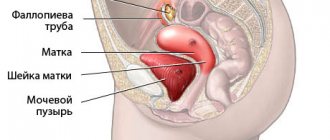Miscarriage is a spontaneous termination of pregnancy that occurs at any stage up to 22 weeks; later miscarriage is classified as premature birth. The percentage of pregnant women who, for one reason or another, experience failure to embroider varies between 10-25%.
Successful treatment for infertility, unfortunately, does not always result in the birth of a child. Termination of a long-awaited pregnancy becomes a real tragedy for a married couple and for their attending physician.
The causes of early miscarriage are often unknown, although chromosomal abnormalities are usually implicated. If a woman has had a miscarriage in the second trimester or two or more in the first trimester, testing is recommended to help determine the causes.
Make an appointment
More often, cases of miscarriage are observed in women who have been treated for infertility, including using IVF. However, the IVF procedure itself can in no way be the cause of a miscarriage.
Causes of miscarriage:
Chromosomal problems
Up to 70% of all miscarriages occurring in the first trimester are caused by abnormalities of somatic chromosomes in the fetus. Most fetal chromosomal abnormalities result from the participation of a defective egg or sperm in fertilization.
In such cases, the resulting embryo has a chromosomal abnormality, which leads to a non-developing pregnancy. Chromosomal abnormalities become more frequent with age.
Women over 35 years of age have a higher risk of miscarriage than those younger. Recent research shows that paternal age over 40 also increases the risk of miscarriage.
Pathology of the uterus
In 10-15% of cases, uterine anomalies (congenital abnormalities of shape, septum in the uterine cavity, fibroids, adenomyosis, scar postoperative changes) are the cause of miscarriage in both the first and second trimester.
Isthmic-cervical insufficiency (weakness of the muscle ring of the cervix) can lead to miscarriage, usually between 16 and 18 weeks of pregnancy.
Hormonal reasons
If the body produces too much or too little of certain hormones, the risk of miscarriage increases. Hyperandrogenism, luteal phase deficiency, hypo- and hyperthyroidism, hyperprolactemia, diabetes mellitus can cause miscarriage.
Autoimmune problems
While everyone's body produces proteins called antibodies to fight infections, some people's bodies produce antibodies (autoantibodies) that can attack the body's own tissues, causing a range of health problems.
They can cause infertility or miscarriage.
Certain types of autoantibodies (such as anticardiolipin or lupus anticoagulant) cause blood clots that can block blood supply to the uterus. Mutations in the blood coagulation system can also cause recurrent miscarriage.
Infections and other factors
Termination of pregnancy due to an inflammatory process is caused by the penetration of infectious agents from the mother's body through the placenta to the fetus. The most dangerous infection is during pregnancy.
The presence of microorganisms in the mother may be asymptomatic or accompanied by characteristic signs of an inflammatory disease. Bacteria (Gram-negative and Gram-positive cocci, Listeria, Treponema and Mycobacteria), protozoa (Toxoplasma, Plasmodium) and viruses can penetrate from the mother into the fetus's body.
Spouses should also discuss possible exposure to chemicals in their workplaces with their healthcare provider.
A woman is not recommended to try to become pregnant until she is physically and emotionally ready and has completed all the investigations recommended to identify the causes of miscarriage.
From a medical point of view, conception is safe from the moment of at least one menstrual cycle (if no research or treatment is carried out on the causes of previous miscarriage). However, it may take much longer before a woman is emotionally ready for pregnancy. Fortunately, the vast majority of women who have experienced one or two miscarriages successfully carry their next pregnancy to term.
In complex cases, there are special treatment methods using preimplantation genetic diagnosis (PGD). PGD allows genetic testing of the embryo before it is transferred into the uterine cavity. This technique is carried out as part of an IVF program and allows only “healthy” embryos that have not been identified to have any genetic diseases to be transferred into the uterine cavity.
They can not only lead to miscarriage, but also provoke infertility.
Otherwise there is a threat of miscarriage
The emergence of a threat is associated with several risk factors. Their list can be presented in the following sequence.
- Social reasons
: hard physical work, night shifts. A pregnant woman should be transferred to light work, and only during the daytime. - Prolonged stress.
- Smoking and drinking alcohol
are bad habits that should be avoided. - Previous illnesses, miscarriages, surgeries.
- The presence of a predisposition
is the aggravated consequences of a genetic factor on the parental side. - Too young or over 35 years of age.
- Concomitant diseases
- pathologies of the thyroid gland, diabetes, high weight, disorders of the heart, kidneys and blood vessels. - can cause termination of pregnancy .
When can you get pregnant after a miscarriage?
A woman is not recommended to try to become pregnant until she is physically and emotionally ready and has completed all the investigations recommended to identify the causes of miscarriage.
From a medical point of view, conception is safe from the moment of at least one menstrual cycle (if no research or treatment is carried out on the causes of previous miscarriage).
However, it may take much longer before a woman is emotionally ready for pregnancy. Fortunately, the vast majority of women who have experienced one or two miscarriages do not suffer from infertility and successfully carry their next pregnancy to term.
How is diagnosis carried out?
The basis of diagnosis is clinical manifestations and additional methods that are used in hospitals. The main signs are bloody discharge and nagging pain in the lower abdomen. If these manifestations pass quickly, they may indicate short-term uterine tone. But if we are talking about frequent manifestations, then the threat of interruption is likely.
Bloody discharge is common during IVF protocols. In this case, the cause of the symptoms is detachment of the ovum. The patient is prescribed hormonal drugs, and the problem goes away. It is important to exclude gene changes and inflammatory processes.
If in the late stages of pregnancy there is bleeding that is not related to the consequences of IVF, you need to call an ambulance. In the hospital, the pregnancy is likely to be prolonged. The main way to overcome miscarriage is to prevent miscarriage.
Preparing for pregnancy in case of recurrent miscarriage
If there have already been 2 or more cases of spontaneous abortion, preparation is necessary before the next conception of a child. A reproductive specialist will prescribe a series of studies aimed at identifying the cause of miscarriage. Many diagnostic measures are similar to those prescribed for infertility. The woman will have to:
- take blood tests for hormones - to identify an endocrine factor;
- undergo smears and blood tests for infections;
- visit a hemostasiologist;
- take an extended coagulogram;
- get advice from a geneticist;
- undergo instrumental studies to diagnose possible inflammatory diseases of the genital organs and detect uterine factor.
A man should also visit a geneticist, as well as take a spermogram and test for sperm DNA fragmentation. It is likely that it is the male reproductive cells that carry defective genetic material. It can cause both infertility and miscarriage.
The choice of studies for a woman largely depends on the trimester in which spontaneous termination of pregnancy occurs. So, in the first trimester, an endocrine factor becomes the cause of miscarriage much more often, so the most important thing is to study the level of hormones in the blood. In the second trimester, disturbances in the hemostatic system or uterine factor (isthmic-cervical insufficiency) often come to the fore.
Further preparation for pregnancy may include:
- correction of hormonal levels;
- treatment of inflammatory diseases of the pelvic organs;
- elimination of disturbances in the hemostasis system;
- surgical treatment if there is a uterine factor of miscarriage;
- IVF with PGD in case of suspected genetic factor.
What can a woman do to prevent miscarriage?
Episodes of abortion do not always indicate a pathological process. It is likely that the examination will not reveal any abnormalities, and then the next pregnancy will end in childbirth.
Early miscarriage
Spontaneous abortion is common in the first trimester. According to statistics, every eighth woman. She may not know about pregnancy, believing that her period has been delayed.
If the embryo comes out completely, the pain stops. If the embryo is not completely released, then prolonged bleeding occurs. When a woman goes to the doctor, she is diagnosed with miscarriage. In such cases, to restore the body, a miscarriage doctor
prescribes a course of treatment.
Genetic causes
At conception, the cell from which the future baby develops receives a certain set of chromosomes. If this mechanism fails, the set of chromosomes will differ from normal. Often cells with such a set of chromosomes are not capable of survival and further division, as happens during normal pregnancy. As a result, it is interrupted. If mutations and damage to the genetic material occur in many germ cells of the parents, then the pregnancy can be interrupted more than once. According to statistics, during spontaneous abortions in the early stages, about 73% of embryos suffered from chromosomal abnormalities.
Hormonal reasons
Hormones are responsible for the readiness of a woman’s body for pregnancy. If the balance of hormones in the blood is disturbed, the uterine mucosa does not have time to prepare in time to strengthen the egg on it; as a result, the embryo develops in unfavorable conditions and does not receive enough nutrients. Therefore, at a certain point, all violations reach a critical level and the pregnancy is terminated.
For a favorable pregnancy, the normal functioning of the thyroid gland, adrenal glands, and ovaries is important. Sex hormones are responsible for the development of the placenta, the lining of the uterus, and prevent its next rejection (as during menstruation). The thyroid gland and adrenal glands are responsible for the normal metabolic rate in the body of the expectant mother, ensuring a timely and sufficient supply of all nutrients to the child.
Consultation with an obstetrician-gynecologist
If a woman has a history of repeated miscarriage, and there are plans to give birth to a healthy baby, it is necessary to contact infertility specialists at the gynecological department of the Central Clinical Hospital of the Russian Academy of Sciences, where they can undergo a diagnosis of the causes of the pathology, find out the exact diagnosis and receive recommendations for treatment.
Call to find out what tests are needed and how much the initial appointment costs. You can make an appointment with a gynecologist at the antenatal clinic of the Russian Academy of Sciences by telephone or on the clinic’s website around the clock.
Effective treatment of recurrent miscarriage under the supervision of experienced specialists is an opportunity to get rid of women’s health problems in the shortest possible time and carry a long-awaited baby.
Constitutional reasons
Sometimes the uterus and other female genital organs have congenital or acquired deviations from the normal structure. These deviations interfere with the normal attachment of the future embryo to the uterine mucosa. A similar problem occurs with a bicornuate uterus, intrauterine septum, as well as with tumors in the uterine cavity (fibroids) or with postoperative scars of its wall. It happens that the fertilized egg does not even get inside the uterus, because it encounters an obstacle along the way. The obstacle may be adhesions that arise after inflammation, or congenital narrowing of the lumen of the fallopian tube.










